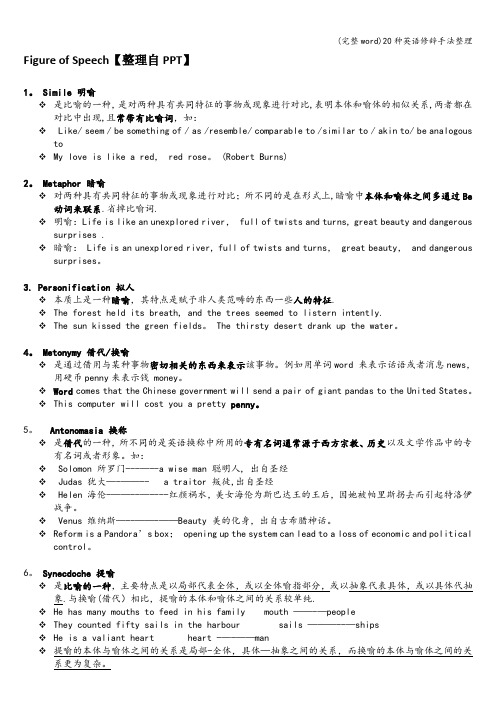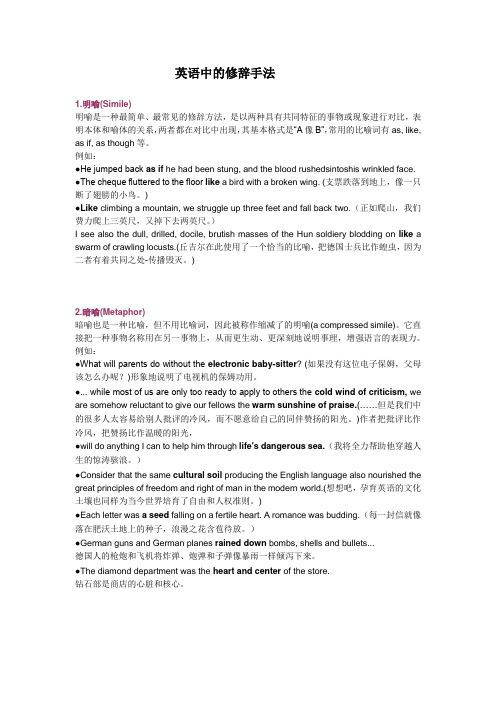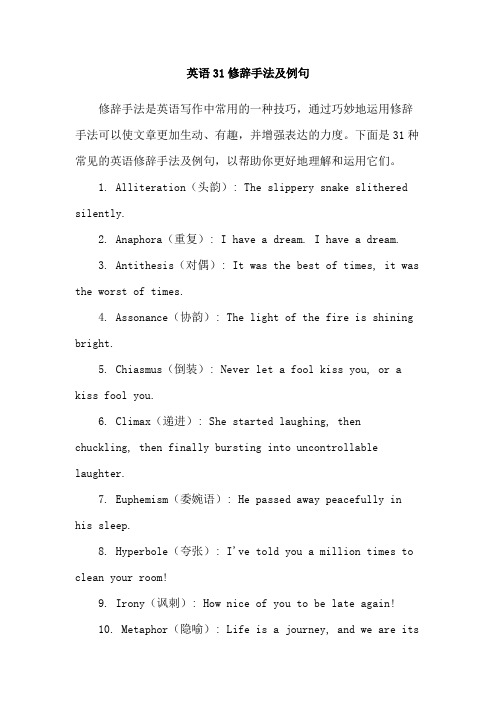英语修辞大全
(完整word)20种英语修辞手法整理

Figure of Speech【整理自PPT】1。
Simile 明喻❖是比喻的一种,是对两种具有共同特征的事物或现象进行对比,表明本体和喻体的相似关系,两者都在对比中出现,且常带有比喻词,如:❖ Like/ seem / be something of / as /resemble/ comparable to /similar to / akin to/ be analogous to❖My love is like a red, red rose。
(Robert Burns)2。
Metaphor 暗喻❖对两种具有共同特征的事物或现象进行对比;所不同的是在形式上,暗喻中本体和喻体之间多通过Be 动词来联系.省掉比喻词.❖明喻:Life is like an unexplored river, full of twists and turns, great beauty and dangerous surprises .❖暗喻: Life is an unexplored river, full of twists and turns, great beauty, and dangerous surprises。
3. Personification 拟人❖本质上是一种暗喻,其特点是赋予非人类范畴的东西一些人的特征.❖The forest held its breath, and the trees seemed to listern intently.❖The sun kissed the green fields。
The thirsty desert drank up the water。
4。
Metonymy 借代/换喻❖是通过借用与某种事物密切相关的东西来表示该事物。
例如用单词word 来表示话语或者消息news,用硬币penny来表示钱 money。
❖Word comes that the Chinese government will send a pair of giant pandas to the United States。
英语18种重要修辞手法

18种重要修辞手法一、语义修辞1明喻(simile)俗称直喻,是依据比喻和被比喻两种不同事物的相似关系而构成的修辞格。
例如:a figure of speech in which denotes a simmilarility betwe en things of different kinds.1.The snow was like a white blanket drawn over the field.2.He was like a cock who thought the sun had risen to hear him crow.认真观察以上各例,我们会发现它们的特点,由(as)... as, like等引导,这些引导词被称作比喻词(acknowledging word),它们是辨别明喻的最显著的特征,明喻较为直白,比喻物和被比喻物之间相似点较为明显,所以明喻是一种比较好判断的修辞手法。
2暗喻(metaphor)也称隐喻,是依据比喻和被比喻两种不同事物的相似或相关关系而构成的修辞格。
例如:a figure of speech in which refers to sth that denotes literally in order to suggest a similarity.1.His friend has become a thorn in his side.(他的朋友已变成眼中钉肉中刺。
)2.You are your mother’s glass.(你是你母亲的翻版。
)3.Hope is a good breakfast, but it’s a bad supper.由以上各例可知,暗喻没有引导词,这是明喻和暗喻在形式上的最大区别。
换句话说,有为明喻,没有为暗喻。
如:He has a heart of stone. He has a heart like stone.很显然,前句是暗喻,后句是明喻。
(完整版)英语中的修辞手法

英语中的修辞手法1.明喻(Simile)明喻是一种最简单、最常见的修辞方法,是以两种具有共同特征的事物或现象进行对比,表明本体和喻体的关系,两者都在对比中出现,其基本格式是“A像B”,常用的比喻词有as, like, as if, as though等。
例如:●He jumped back as if he had been stung, and the blood rushedsintoshis wrinkled face.●The cheque fluttered to the floor like a bird with a broken wing. (支票跌落到地上,像一只断了翅膀的小鸟。
)●Like climbing a mountain, we struggle up three feet and fall back two.(正如爬山,我们费力爬上三英尺,又掉下去两英尺。
)I see also the dull, drilled, docile, brutish masses of the Hun soldiery blodding on like a swarm of crawling locusts.(丘吉尔在此使用了一个恰当的比喻,把德国士兵比作蝗虫,因为二者有着共同之处-传播毁灭。
)2.暗喻(Metaphor)暗喻也是一种比喻,但不用比喻词,因此被称作缩减了的明喻(a compressed simile)。
它直接把一种事物名称用在另一事物上,从而更生动、更深刻地说明事理,增强语言的表现力。
例如:●What will parents do without the electronic baby-sitter? (如果没有这位电子保姆,父母该怎么办呢?)形象地说明了电视机的保姆功用。
●... while most of us are only too ready to apply to others the cold wind of criticism, we are somehow reluctant to give our fellows the warm sunshine of praise.(……但是我们中的很多人太容易给别人批评的冷风,而不愿意给自己的同伴赞扬的阳光。
英文修辞手法

常见英语修辞手法总共有22种,分别为明喻、转喻、提喻、隐喻、拟人、拟声、夸张、双关、讽刺、联觉、头韵、委婉、修辞反问、隽语、对照、渐进法、渐降法、引用、叠言、仿拟、排比、寓言。
一、明喻(Simile)是以两种具有相同特征的事物和现象进行对比,表明本体和喻体之间的相似关系,两者都在对比中出现。
常用比喻词like, as, as if, as though,seem,similar to, such as等,Eg:1. This elephant is like a snake as anybody can see.这头象和任何人见到的一样像一条蛇。
2. He looked as if he had just stepped out of my book of fairytales and had passed me like a spirit.他看起来好像刚从我的童话书中走出来,像一个幽灵一样从我身边走过。
3. It has long leaves that sway in the wind like slim fingers reaching to touch something.它那长长的叶子在风中摆动,好像伸出纤细的手指去触摸什么东西似的。
二、隐喻(Metaphor)这种比喻不通过比喻词进行,而是直接将用事物当作乙事物来描写,甲乙两事物之间的联系和相似之处是暗含的。
Eg:1、The diamond department was the heart and center of the store. 钻石部是商店的心脏和核心。
2. He is a pig.他简直是头猪。
(比喻:他是一个像猪一般的人,指肮脏,贪吃的人。
)3. She is a woman with a stony heart.她是一个铁石心肠的女人。
(比喻:这个女人冷酷无情。
)4.Mark Twain is a mirror of America.马克吐温是美国的一面镜子。
十九种英语修辞手法的详细解释和例句

英语中所有19种修辞手法的全部解释和例句,英语中所有19种修辞手法的全部解释和例句:Simile明喻、Metaphor 隐喻,暗喻、Metonymy 借喻,转喻、Synecdoche 提喻、Synaesthesia 通感,联觉,移觉、Personification 拟人、Hyperbole 夸张、Parallelism 排比, 平行、Euphemism 委婉,婉辞法、Allegory 讽喻,比方、Irony 反语、Pun 双关、Parody 仿拟、Rhetorical question 修辞疑问、Antithesis 对照,对比,对偶、Paradox 隽语、Oxymoron 反意法,逆喻、Climax 渐进法,层进法、Anticlimax 渐降法。
快来学习吧! 1.Simile 明喻 明喻是将具有共性的不同事物作对比.这种共性存在于人们的心里,而不是事物的自然属性. 标志词常用 like, as, seem, as if, as though, similar to, such as 等. 例如: 1>.He was like a cock who thought the sun had risen to hear him crow. 2>.I wandered lonely as a cloud. 3>.Einstein only had a blanket on, as if he had just walked out of a fairy tale. 2.Metaphor 隐喻,暗喻 隐喻是简缩了的明喻,是将某一事物的名称用于另一事物,通过比较形成. 例如: 1>.Hope is a good breakfast, but it is a bad supper. 2>.Some books are to be tasted, others swallowed, and some few to be chewed and digested. 3.Metonymy 借喻,转喻 借喻不直接说出所要说的事物,而使用另一个与之相关的事物名称. I.以容器代替内容,例如: 1>.The kettle boils. 水开了. 2>.The room sat silent. 全屋人安静地坐着. II.以资料.工具代替事物的名称,例如: Lend me your ears, please. 请听我说. III.以作者代替作品,例如: a complete Shakespeare 莎士比亚全集 VI.以具体事物代替抽象概念,例如: I had the muscle, and they made money out of it. 我有力气,他们就用我的力气赚钱. 4.Synecdoche 提喻 提喻用部分代替全体,或用全体代替部分,或特殊代替一般. 例如: 1>.There are about 100 hands working in his factory.(部分代整体) 他的厂里约有100名工人. 2>.He is the Newton of this century.(特殊代一般) 他是本世纪的牛顿. 3>.The fox goes very well with your cap.(整体代部分) 这狐皮围脖与你的帽子很相配. 5.Synaesthesia 通感,联觉,移觉 这种修辞法是以视.听.触.嗅.味等感觉直接描写事物.通感就是把不同感官的感觉沟通起来,借联想引起感觉转移,“以感觉写感觉”。
英语修辞法18种

英语修辞法18种1. 明喻(Simile)明喻是指为了鲜明地刻画某一事,将具有某种共同特征的两种事物加以对比。
它由本体、喻体和比喻词组成。
常用的比喻词有as、like、as if、as though、as... as、similar to、to bear a resemblance to等等。
明喻能使深奥的哲理变得浅显易懂。
A man without religion is like a horse without a bridle.人无信仰,犹如马无缰绳。
Fire is as hurtful as healthful.火能成灾,也能造福。
Use a book as a bee does flowers.读书如蜜蜂采蜜。
Wit without learning is like a tree without fruit.没有学识的机智犹如没有果实的树。
Beauty without virtue is like a rose without scent.美而无德犹如花无香味。
2. 暗喻(Metaphor)暗喻亦称为“隐喻”,它同明喻一样,也是在两个不同类对象之间进行比喻,区别在于:明喻把本体和喻体说成是相似的,而暗喻则把两者说成是一致的;明喻中有比喻词,而暗喻中不用比喻词。
A good book is the best of friends, the same today and forever.好书如相伴终生的挚友。
A dwarf on a giant’s shoulders sees the farther of the two.侏儒站在巨人的肩上,会看得更远。
Fire is a good servant but a bad master.火是忠仆,用之不慎成灾主。
A word spoken is an arrow let fly.出口的话如同离弦的箭。
A teacher for a day is a father for a lifetime.一日为师,终身为父。
英语18种重要修辞手法

18种重要修辞手法一、语义修辞1明喻(simile)俗称直喻,是依据比喻和被比喻两种不同事物的相似关系而构成的修辞格。
例如:a figure of speech in which denotes a simmilarility betwe en things of different kinds.1.The snow was like a white blanket drawn over the field.2.He was like a cock who thought the sun had risen to hear him crow.认真观察以上各例,我们会发现它们的特点,由(as)... as, like等引导,这些引导词被称作比喻词(acknowledging word),它们是辨别明喻的最显著的特征,明喻较为直白,比喻物和被比喻物之间相似点较为明显,所以明喻是一种比较好判断的修辞手法。
2暗喻(metaphor)也称隐喻,是依据比喻和被比喻两种不同事物的相似或相关关系而构成的修辞格。
例如:a figure of speech in which refers to sth that denotes literally in order to suggest a similarity.1.His friend has become a thorn in his side.(他的朋友已变成眼中钉肉中刺。
)2.You are your mother’s glass.(你是你母亲的翻版。
)3.Hope is a good breakfast, but it’s a bad supper.由以上各例可知,暗喻没有引导词,这是明喻和暗喻在形式上的最大区别。
换句话说,有为明喻,没有为暗喻。
如:He has a heart of stone. He has a heart like stone.很显然,前句是暗喻,后句是明喻。
英语31修辞手法及例句

英语31修辞手法及例句修辞手法是英语写作中常用的一种技巧,通过巧妙地运用修辞手法可以使文章更加生动、有趣,并增强表达的力度。
下面是31种常见的英语修辞手法及例句,以帮助你更好地理解和运用它们。
1. Alliteration(头韵): The slippery snake slithered silently.2. Anaphora(重复): I have a dream. I have a dream.3. Antithesis(对偶): It was the best of times, it was the worst of times.4. Assonance(协韵): The light of the fire is shining bright.5. Chiasmus(倒装): Never let a fool kiss you, or a kiss fool you.6. Climax(递进): She started laughing, then chuckling, then finally bursting into uncontrollable laughter.7. Euphemism(委婉语): He passed away peacefully in his sleep.8. Hyperbole(夸张): I've told you a million times to clean your room!9. Irony(讽刺): How nice of you to be late again!10. Metaphor(隐喻): Life is a journey, and we are itspassengers.11. Onomatopoeia(拟声): The bees buzzed by my ear.12. Oxymoron(矛盾修饰): The silence was deafening.13. Parallelism(并列结构): She likes cooking, swimming, and reading.14. Personification(拟人): The flowers danced in the wind.15. Pun(双关): I used to be a baker, but I couldn't make enough dough.16. Repetition(重复): I must do it. I will do it. I can do it.17. Rhetorical question(修辞疑问): Who can resist the aroma of freshly baked bread?18. Simile(明喻): Her smile is as bright as the sun.19. Synecdoche(提喻法): The pen is mightier than the sword.20. Allusion(典故): She had a Mona Lisa smile on her face.21. Apostrophe(呼唤): Oh, love, why do you torment me so?22. Consonance(协音): The ship has sailed to the farthest shores.23. Enjambment(跨行): I wandered lonely as a cloudThat floats on high o'er vales and hills.24. Litotes(婉言): She is not unkind.25. Metonymy(转喻): The pen is mightier than the sword.26. Paradox(悖论): The more you know, the more you don't know.27. Periphrasis(迂回说法): The city that never sleeps (New York City).28. Sarcasm(讽刺): Oh, you're so clever, I can hardly stand it.29. Symbolism(象征): The dove represents peace.30. Understatement(轻描淡写): It's just a little cut, no need to make a fuss.31. Zeugma(两义): She lost her keys and her temper.这些修辞手法在英语写作中非常常见,它们可以使文章更加生动有趣,同时也能够增强表达的力度。
- 1、下载文档前请自行甄别文档内容的完整性,平台不提供额外的编辑、内容补充、找答案等附加服务。
- 2、"仅部分预览"的文档,不可在线预览部分如存在完整性等问题,可反馈申请退款(可完整预览的文档不适用该条件!)。
- 3、如文档侵犯您的权益,请联系客服反馈,我们会尽快为您处理(人工客服工作时间:9:00-18:30)。
本文根据《大学英语》中出现的最常见的几种修辞格加以分析,希望有助于大家在学习英语的过程中能够恰当地选择修辞手段来丰富自己的表达。
明喻(Simile)明喻是一种最简单、最常见的修辞方法,是以两种具有共同特征的事物或现象进行对比,表明本体和喻体的关系,两者都在对比中出现,其基本格式是“A像B”,常用的比喻词有as, like, as if, as though等。
例如:●He jumped back as if he had been stung, and the blood rushedsint oshis wrinkled face.(他往后一跳,好像被什么东西叮了一下似的,他那张布满皱纹的脸顿时涨得通红。
)在《品尝家》一文中老人对“我”的慷慨施舍的反应如同被蜜蜂叮过一样,生动地刻画出一个处境凄凉内心却极度敏感的可怜老人的形象。
●The cheque fluttered to the floor like a bird with a broken wing. (支票跌落到地上,像一只断了翅膀的小鸟。
)《礼物》一文中,老太太喜迎八十大寿,大女儿不来庆祝,只寄来一张支票。
作者把这张支票比作断了翅膀的小鸟,形象地表达出此刻老太太希望破灭,极度伤心的心情。
暗喻(Metaphor)暗喻也是一种比喻,但不用比喻词,因此被称作缩减了的明喻(a compressed simile)。
它直接把一种事物名称用在另一事物上,从而更生动、更深刻地说明事理,增强语言的表现力。
例如:●What will parents do without the electronic baby-sitter? (如果没有这位电子保姆,父母该怎么办呢?)形象地说明了电视机的保姆功用。
●... while most of us are only too ready to apply to others the cold wind of criticism, we are somehow reluctant to give our fellows the warm sunshine of praise.(……但是我们中的很多人太容易给别人批评的冷风,而不愿意给自己的同伴赞扬的阳光。
)作者把批评比作冷风,把赞扬比作温暖的阳光,生动形象,寓意隽永。
转喻(Metonymy)转喻(即借代)是通过相近的联想,借喻体代替本体。
例如:●My 15 students read Emerson, Thoreau, and Huxley.(我的十五位学生读了爱默生、梭罗和赫胥黎的作品。
)这是典型的转喻,以人名借代作品。
●Against the Oval Earth man, the first card I can play is the analogy of the sun and moon. (面对“地球卵形说”者,我能打的第一张牌是,太阳和月亮的相似性。
)文中作者用具体第一张牌来借代抽象的“第一个论据”,更加生动形象,浅显易懂,也使语言新鲜活泼,富有表现力。
拟人(Personification)拟人是把人类的特点、特性加于外界事物上,使之人格化的修辞格。
例如:●... four evergreen shrubs stood at each corner,swheresthey struggled to survive the dust and fumes from a busy main road.(……四丛常绿灌木分别位于每个角落,它们忍受着从繁忙的大街上吹来的尘烟,挣扎着活下去。
)“挣扎”是有生命的物体的动作,作者给自然的花草赋予了生命,使它人格化。
●But the houses were cold, closed, unfriendly.(可是那些房子冷漠无情,门窗紧闭,一点也不友好。
)house本来是没有感情的,作者通过拟人的手法,表现房子里人的冷漠无情。
夸张(Hyperbole)夸张是一种故意言过其实,或夸大或缩小事物的形象,借以突出事物的某种特征或品格,鲜明地表达思想情感的修辞方式。
用于描写可以使形象更生动突出,渲染气氛,烘托意境,给读者留下深刻、鲜明的印象。
例如:●Vingo sat stunned, looking at the oak tree. It was covered with yellow handkerchiefs—20 of them, 30 of them, maybe hundreds.(文戈坐在那儿望着橡树惊呆了。
树上挂满了黄手绢——二十条,三十条,或许几百条。
)此句中20 of them, 30 of them, maybe hundreds就是运用了夸张的手法,主观地渲染了气氛。
●She gave me the impressi on ofshavingsmore teeth, white and large and even, than were necessary for any practical purpose.(她给我的印象是:她有一口洁白整齐的大牙,为数之多已超过任何实际需要。
)在这里作者通过夸张的描述,使一个贪婪好吃的女性形象跃然纸上。
反语(Irony)英语修辞格irony就是说反话,用反面的话来表达正面的意思。
这种修辞格可用来进行讽刺,但多数是用来表达一种善意的幽默或俏皮,故意说出与本意相反的话,例如:●Slowly the old lady stooped to pick it (the cheque ) up. Her present, her lovely present. With trembling fingers she tore itsintoslittle bits. (老太太慢慢地弯下腰,把支票从地上捡起来,她的礼物,她的可爱的礼物!用颤抖的手指把它撕得粉碎。
)老太太八十岁寿辰那天,急切地盼望女儿回家看望她,稍稍安慰她那颗孤寂的心,然而盼来的却是女儿的一张冷冰冰的支票,这当然不是老人心爱的礼物。
故此处her lovely present是典型的irony,是句反话。
●She was not so young as I expected and in appearance imposing rather than attractive.(她并不如我想象的那么年轻。
她的外表与其说吸引人,不如说是令人难忘。
)imposing意指因为外貌、形体而使人印象深刻,作者在此以讽刺挖苦的口吻来描述一个贪吃而肥胖的女人。
仿拟(Parody)根据家喻户晓的成语或谚语,临时更换其中的某个部分,造成新的成语或谚语;或者根据古今名言警句,在保持其原句不变的情况下,更换其中部分词语,这种修辞方式叫仿拟。
例如:●To lie or not to lie-the doctor's dilemma(撒谎还是不撒谎——医生的难题)看到这个标题,我们不禁想起莎翁戏剧Hamlet中那个永远也解不透的句子“To be or not to be, that is the question”。
显然,文章的题目由此模仿而来,给人印象深刻。
●Lady hermits who are down but not out(穷困而不潦倒的女隐士们)文中的down but not out源于down and out,原是拳击比赛的术语,后来喻指穷困潦倒的人。
矛盾修辞法(Oxymoron)用两种不相调和,甚至截然相反的特征来形容一项事物,在矛盾中寻求哲理,以便收到奇警的修辞效果,这就是矛盾修辞法,用这种方法,语言精炼简洁,富有哲理,并产生强大的逻辑力量,产生一种出人意料,引人入胜的效果。
例如:●A miserable, merry Christmas(悲喜交加的圣诞节)。
圣诞节那天,故事主人公小男孩经历了从痛苦的边缘到幸福的顶峰的过程。
因此,父母精心安排的圣诞节既是最糟的,又是最好的。
头韵(Alliteration)与前面几种修辞方式不同,头韵是一种语音修辞方式,它指一组词、一句话或一行诗中重复出现开头字母相同的单词,常用于文章的标题、诗歌及广告语中,简明生动,起到突出重点,加深印象,平衡节奏,宣泄感情的作用。
例如:●A miserable, merry Christmas●Profits of praise英语的修辞可以分为消极修辞和积极修辞两大类。
一、消极修辞(Passive Rhetoric Techniques)它主要指那些没有相对固定格式的修辞性写作技巧,它与语法、语言结构和词汇的关系密切,只是为了修辞和立意新颖的缘故,对之做了一些调整。
举一种情况进行说明:为了增加文采,强化文章的表现力,常常避免重复使用同一个词汇,而另选他词。
这种无固定格式可循的消极修辞手段被称为Elegant Variation(求雅换词)。
如在Elizabeth Razzi写的题为10 Ways to Lose Pounds 的文章中,“减肥”的表达竟有8种,文笔活泼,文采灿然:1. Try to shed a few extra pounds?2. Studies show these efforts may shave off the pounds quickly.3. Here are ten simple strategies that can help melt away your fat forever.4. …like a logical way to peel off a few pounds.5. …roughly the amount neede d to burn off one pound.6. You must eat less to lose weight.7. A key obstacle to dropping extra pounds is after-dinner snacking.8. 10 Ways to Lose Pounds.以上8句中的斜体字让我们欣赏了英语词汇的活力与风采。
遗憾的是,大部分精彩的用词不能直译。
求雅换词的手法之一是大字小用,或小词大用。
如:Don’t take the low-fat label as a license to eat. 句子写得精彩,最难忘的是其中license一词。
它是用途很广的大词。
用在这里给人一种“头小帽大”的感觉,新颖别致。
译文很难挽留此韵。
(不能因为食品标明低脂肪,而敞开食用。
)再如:If the term sounds unscientific to 20th-century ears, let us remember there is a definite connection between marshy lands and malaria… (如果这个术语对生活在20世纪的人听来不科学的话,那就让我们记住在沼泽地和疟疾之间有一定的联系……)。
